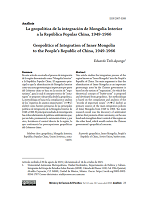Geopolitics of Integration of Inner Mongolia to the People’s Republic of China, 1949-1966
DOI:
https://doi.org/10.32870/mycp.v12i34.786Keywords:
Geopolitics, Inner Mongolia, People´ s Republic of China, Soviet Union, Buffer-zoneAbstract
This article studies the integration process of the region known as “Inner Mongolia” into the People’s Republic of China. The main argument is that the identification of Inner Mongolia as an important geostrategic zone by the Chinese government is based on the notion of “separatism”, for which the theoretical concept of “buffer-zone” is proposed and developed from geopolitics. The methodology is based on the compilation and analysis of the “records of important issues” (?? dashiji) as primary sources of the main integration policies of Inner Mongolia from 1949 to 1966. The main research result was the discovery of ambivalent policies that promote ethnic autonomy, on the one hand and strengthen direct control of the region on the other hand, which would confirm the Chinese government’s geopolitical concerns.Downloads
References
ABCh. (2017, julio 24). ?????? Zhongguo Fojiao Xuehui [Introducción a la Asociación Budista de China]. The Budist Association of China. https://www.chinabuddhism.com.cn/e/action/ListInfo/?classid=540
Atwood, C. (1990). Nationalism and Localism: The Origins of the People’s Revolutionary
Party of Inner Mongolia [Tesis de maestría, Indiana University].
Baranovitch, N. (2016). The 2011 Protests in Inner Mongolia: An Ethnoenvironmental
Perspective. The China Quarterly, 225, 214-233. https://doi.org/10.1017/S0305741015001642
Bawden, C. R. (2010). The Mongol Rebellion of 1756-1757. En D. Sneath & C. Kaplonski (Eds.), The History of Mongolia: Vol. I. The Pre-Chinggisid Era Chinggis Khan and the Mongol Empire (pp. 750-770). Global Oriental. (Reimpreso de The History of Mongolia, pp. 750-770, por D. Sneath & C. Kaplonski, Eds., 1967, Brill).
Bello, D. A. (2016). Across Forest, Steppe, and Mountain. Environment, Identity, and Empire in Qing China’s Borderlands. Cambridge University Press.
Bilik, N. (2007). Names Have Memories: History, Semantic Identity and Conflict in Mongolian and Chinese Language Use. Inner Asia, 9(1), 23-39. https://doi.org/10.1163/146481707793646629
Borjigin, H. (2004). The History and the Political Character of the name ‘Nei Menggu’ (Inner Mongolia). Inner Asia, 6(1), 61-80. https://doi.org/10.1163/146481704793647207
Brown, K. (2007). The Cultural Revolution in Inner Mongolia 1967–1969: The Purge of the “Heirs of Genghis Khan”. Asian Affairs, 38(2), 173-187. https://doi.org/10.1080/03068370701349128
Bulag, U. E. (2002). The Mongol’s at China’s Edge. History and the Politics of National Unity.
Rowman & Littlefield Publishers.
Bulag, U. E. (2010). Alter/native Mongolian identity. From nationality to ethnic group. En E. J. Perry, & M. Selden (Eds.), Chinese Society. Change, Conflict and Resistance (3ra edición, pp. 261-287). Routledge. https://doi. org/10.4324/9780203856314
Cabrera, L. (2020). Geopolítica crítica: alcances, límites y aportes para los estudios internacionales en Sudamérica. Foro internacional, 60(1), 61-95. https://doi.org/10.24201/fi.v60i1.2574
Chang, W. (2019). Cultural Implications of Mongolian Women’s Clothing in Xingmeng Township of Tonghai of Yunnan Province. Advances in Social Science, Education and Humanities Research, 329, (pp. 946-949). https://doi.org/10.2991/iccessh-19.2019.212
Chen, F., & Li, R. (2019, octubre 21). ?????????????????? [¿Por qué la primera región autónoma se estableció antes que la Nueva China?]. Renmin Ribao [Diario del Pueblo en Línea]. http://politics. people.com.cn/n1/2019/1021/c429373-31410351.html
Day, P. (2012, marzo 17). Ordos: The biggest ghost town in China. BBC News. https://www.bbc.com/news/magazine-17390729
Discurso del camarada Ulanhu sobre la exitosa resolución del Partido de la Cuestión Nacional Interna. (1956, septiembre 20). Renmin Ribao, p. 7 [Diario del Pueblo]. https://cn.govopendata.com/renminribao/1956/9/20/7/
Ewing, T. E. (1978). Revolution on the Chinese Frontier: Outer Mongolia in 1911. Journal of Asian History, 12(2), 101-119. https://www.jstor.org/ stable/41930293
Fletcher, J. (1978). The heyday of the Ch’ing order in Mongolia, Sinkiang and Tibet. En J. K. Fairbank (Ed.), The Cambridge History of China: Vol.10. Late Ch’ing, 1800-1911, Part I (pp. 351-408). Cambridge University Press.https://doi.org/10.1017/CHOL9780521214476.009
Granados, U. (2012). Estudios sobre las fronteras marítimas y la periferia de la otra China: China marítima. En R. Cornejo (Coord.), China. Estudios y ensayos en honor a Flora Botton Beja (pp. 125-162). El Colegio de México.
Grasso, J. (1996). Cold War politics and Mongolia: The Kennedy administration and Mongolia’s entrance to the United Nations. Diplomacy and Statecraft, 7(3), 688-703. https://doi.org/10.1080/09592299608406021
Gutiérrez Chong, N. (2011). Multietnicidad y etnonacionalismo en la República Popular China. Estudios de Asia y África, 46(1), 9-34. https://estudiosdeasiayafrica. colmex.mx/index.php/eaa/article/view/2014
Han, E. (2011). From domestic to international: the politics of ethnic identity in Xinjiang and Inner Mongolia. Nationalities Papers, 39(6), 941-962. https://doi.org/10.1080/00905992.2011.614226
Information Memorandum, ‘About the Claims of the Chinese Leaders With Regard to the Mongolian People’s Republic’ [Information Note]. (1964, enero 30). History and Public Policy Program Digital Archive, Traducción de CWIHP por Sergey Radchenko. ID 113098. https://digitalarchive.wilsoncenter.org/document/113098
Isono, F. (2010). Soviet Russia and the Mongolian Revolution of 1921. En D. Sneath & C. Kaplonski (Eds.), The History of Mongolia: Vol. I. The Pre- Chinggisid Era Chinggis Khan and the Mongol Empire (pp. 910-929). Global Oriental. https://doi.org/10.1163/9789004216358_049 (Reimpreso de “Soviet Russia and the Mongolian Revolution of 1921,” 1979, Past and Present, 83(1), 116-140, https://doi.org/10.1093/past/83.1.116)
Ivanov and Prikhodov Report on the Mongolian Referendum. (1945, noviembre 22). History and Public Policy Program Digital Archive, AVPRF: fond 0111, opis’ 27, papka 193, delo 2, listy 15-21. Traducción de CWIHP por Sergey Radchenko. ID 122625. https://digitalarchive.wilsoncenter.org/
document/122625
Kelly, P. (Ed.). (2006). Classical Geopolitics: A New Analytical Model. Standford University Press. https://doi.org/10.1080/01495933.2016.1222846
Kuo, T. C. (2009). A Strong Diplomat in a Weak Polity: T.V. Soong and wartime US-China relations, 1940–1943. Journal of Contemporary China, 18(59), 219-231. https://doi.org/10.1080/10670560802575994
Leibold, J. (2004). Positioning ‘Minzu’ within Sun Yat-sen’s Discourse of Minzuzhuyi. Journal of Asian History, 38(2), 163-213. https://www.jstor.org/stable/41933382
Li, G. R. (2002). State Building before 1644. En W. J. Peterson (Ed.), The Cambridge History of China Vol. 9 Part One: The Ch’ing Empire to 1800 (pp. 9-72). Cambridge University Press.
Li, X. (2020, marzo 16). ?????? [Cómo escribir registros de asuntos importantes]. Jiaoyu zhijia [Hogar de la educación]. http://www.jiaoyuz.com/fanwen/150217.html
Liu, X. (2020, septiembre 4). Disinformation causes ‘twists’ in bilingual education in China’s Inner Mongolia. Global Times. https://www.globaltimes.cn/ page/202009/1199880.shtml
Qiao, L. (31 de agosto de 2020). Mass Protests Erupt as China Moves to End Mongolian-Medium Teaching in Schools (Traducción y edición L. Mudie). Radio Free Asia. https://www.rfa.org/english/news/china/schools-08312020093412.html
Record of a Meeting between T.V. Soong and Stalin [Meeting Notes]. (1945a, Julio 02). History and Public Policy Program Digital Archive, Victor Hoo Collection, caja 6, carpeta 9, Hoover Institution Archives. ID 122505.
Record of a Meeting Between T.V. Soong and Stalin [Memorandum of Conversation]. (1945b, agosto 10). History and Public Policy Program Digital Archive, Victor Hoo Collection, caja 6, carpeta 9, Hoover Institution Archives. ID 134355. https://digitalarchive.wilsoncenter.org/document/134355
RSRAMI. (1950). 1950?????? [1950 Registro de asuntos importantes de Mongolia Interior]. Consultado el 18 de marzo de 2022. http://www.nmgqq.com.cn/quqinggailan/nemenggudashiji/zhonghuarenmingongheguo/2017-2-18/9841.html
RSRAMI. (1951). 1951?????? [1951 Registro de asuntos importantes de Mongolia Interior]. Consultado el 18 de marzo de 2022. http://www.nmgqq.com.cn/quqinggailan/nemenggudashiji/zhonghuarenmingongheguo/2017-2-18/9843.html
RSRAMI. (1952). 1952?????? [1952 Registro de asuntos importantes de Mongolia Interior]. Consultado el 18 de marzo de 2022. http://www.nmgqq.com.cn/quqinggailan/nemenggudashiji/zhonghuarenmingongheguo/2017-2-18/9844.html
RSRAMI. (1953). 1953?????? [1953 Registro de asuntos importantes de Mongolia Interior]. Consultado el 18 de marzo de 2022. http://www.nmgqq.com.cn/quqinggailan/nemenggudashiji/zhonghuarenmingongheguo/2017-2-18/9846.html
RSRAMI. (1954). 1954?????? [1954 Registro de asuntos importantes de Mongolia Interior]. Consultado el 18 de marzo de 2022. http://www.nmgqq.com.cn/quqinggailan/nemenggudashiji/zhonghuarenmingongheguo/2017-2-18/9848.html
RSRAMI. (1955). 1955?????? [1955 Registro de asuntos importantes de Mongolia Interior]. Consultado el 18 de marzo de 2022. http://www.nmgqq.com.cn/quqinggailan/nemenggudashiji/zhonghuarenmingongheguo/
-2-18/9850.html
RSRAMI. (1957). 1957?????? [1957 Registro de asuntos importantes de Mongolia Interior]. Consultado el 18 de marzo de 2022. http://www. nmgqq.com.cn/quqinggailan/nemenggudashiji/zhonghuarenmingongheguo/2017-2-18/9854.html
RSRAMI. (1958). 1958?????? [1958 Registro de asuntos importantes de Mongolia Interior]. Consultado el 18 de marzo de 2022. http://www.nmgqq.com.cn/quqinggailan/nemenggudashiji/zhonghuarenmingongheguo/2017-2-18/9856.html
RSRAMI. (1959). 1959?????? [1959 Registro de asuntos importantes de Mongolia Interior]. Consultado el 18 de marzo de 2022. http://www.nmgqq.com.cn/quqinggailan/nemenggudashiji/zhonghuarenmingongheguo/2017-2-18/9858.html
RSRAMI. (1960). 1960?????? [1960 Registro de asuntos importantes de Mongolia Interior]. Consultado el 18 de marzo de 2022. http://www. nmgqq.com.cn/quqinggailan/nemenggudashiji/zhonghuarenmingongheguo/2017-2-18/9861.html
RSRAMI. (1966). 1966?????? [1966 Registro de asuntos importantes de Mongolia Interior]. Consultado el 18 de marzo de 2022. http://www.nmgqq.com.cn/quqinggailan/nemenggudashiji/zhonghuarenmingongheguo/2017-2-18/9853.html
Rupen, R. A. (1963). Mongolia in the Sino-Soviet dispute. The China Quarterly, 16, 75-85. https://doi.org/10.1017/S0305741000021512
Sandag, S., & Kendall, H. H. (2000). Poisoned Arrows: The Stalin-Choibalsan Mongolian Massacres, 1921-1941. Westview Press.
Schram, S. (Ed.). (1999). Mao’s Road to Power. Revolutionary Writings 1912- 1945. Vol. V Toward the Second United Front, January 1935-July 1937. M. E. Sharpe.
Silva Michelena, J. A. (1976). Política y bloques de poder. Crisis en el sistema mundial. Siglo XXI Editores.
Sneath, D. (1994). The impact of the Cultural Revolution in China on the Mongolians of Inner Mongolia. Modern Asian Studies, 28(2), 409-430. https://doi.org/10.1017/S0026749X00012464
Sneath, D. (2008). Competing Factions and Elite Power: Political Conflict in Inner Mongolia. En F. Pirie, & T. Huber (Eds.), Conflict and Social Order in Tibet and Inner Asia (pp. 85-112). Brill.
Stalin’s Conversation with Choibalsan. (1944, enero 22). History and Public Policy Program Digital Archive, Lkhamsurengiin Bat Ochir, “Stalin, Choibalsan naryn 1940-uud ony uulzaltuud”, ?Khudulmur?, No 148. pp. 166-167. Traducción de Sergey Radchenko. ID 209765. https://digitalarchive.wilsoncenter.org/document/209765
Teets, J. C. (2013). Let Many Civil Societies Bloom: The Rise of Consultative Authoritarianism in China. The China Quarterly, 213, 19-38. https://doi.org/10.1017/S0305741012001269
Urbansky, S. (2020). Beyond the Steppe Frontier. A History of the Sino-Russian Border. Princeton University Press.
Wang, R., & Groot, G. (2018). Who Represents? Xi Jinping’s Grand United Front Work, Legitimation, Participation and Consultative Democracy. Journal of Contemporary China, 27(112), 569-583. https://doi.org/10.1080/10670564.2018.1433573
Warikoo, K. (2007). Editor’s Page. Himalayan and Central Asian Studies, 11(3-4), 1-4. http://www.himalayanresearch.org/journal-2007.html
Wu, X. (2019, septiembre 6). ????????????? [Ulanhu: un modelo de unidad nacional]. Zhongguo Gongchandang Xinwen Wang [Red de noticias del Partido Comunista de China]. http://dangshi.people.com.cn/n1/2019/0906/c85037-31339626.html
Xinhua. (1956). 1956. http://www.nmg.xinhuanet.com/bnfynmg/bnjs/js12.htm
Xinhua. (1958). 1958. http://www.nmg.xinhuanet.com/bnfynmg/bnjs/js12.htm
Yang, Y. (2021, marzo 5). ????????????? [Xi Jinping participa en las deliberaciones de la delegación de Mongolia Interior]. Guangming [Guangming]. https://politics.gmw.cn/2021-03/05/content_34664468.htm

Downloads
Published
Versions
- 2023-02-20 (4)
- 2022-12-16 (3)
- 2022-12-15 (2)
- 2022-12-15 (1)
How to Cite
Issue
Section
License
Copyright (c) 2022 México y la Cuenca del Pacífico

This work is licensed under a Creative Commons Attribution-NonCommercial-ShareAlike 4.0 International License.
Open Access Policy
This journal provides open access to all its contents, in adherence to the principle that making research freely available supports a greater global exchange of knowledge.
MyCP is licensed under a Creative Commons Attribution-NonCommercial license, also known as CC BY-NC.
Contents are published in both PDF and XML formats.
Authors who publish in México y la Cuenca del Pacífico must accept the following conditions:
Pursuant to Mexican copyright laws, México y la Cuenca del Pacífico acknowledges and respects the authors’ moral right and ownership of property rights, which will be assigned to the University of Guadalajara to publish the articles in an open-access mode.
México y la Cuenca del Pacífico does not charge the authors any fees for receiving and processing their articles.
Authors are permitted to enter into other independent and additional contractual agreements for the non-exclusive distribution of the article version published in México y la Cuenca del Pacífico (for example, publishing it in an institutional repository or in other printed or electronic media) as long as they clearly state that the piece was originally published in México y la Cuenca del Pacífico.
Pursuant to the above, once the article is approved for publication, authors must send the Assignment of Rights Agreement form duly filled and signed. This form must be sent to mexicoylacuenca@gmail.com as a PDF file.
Readers/users of México y la Cuenca del Pacífico can freely access the journal new issues as soon as they are uploaded. Readers/users are allowed to cite, share (both electronically and physically), print and distribute the material, provided they expressly state that the work was originally published in México y la Cuenca del Pacífico. Contents are to be properly cited and never for commercial purposes.




